Mastering French Press Brewing: Techniques and Tips
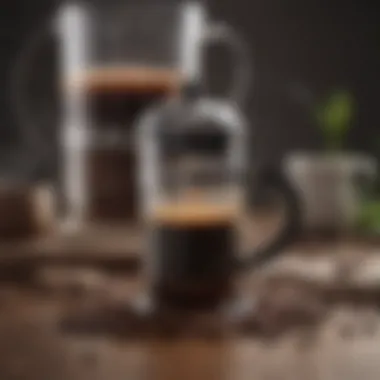
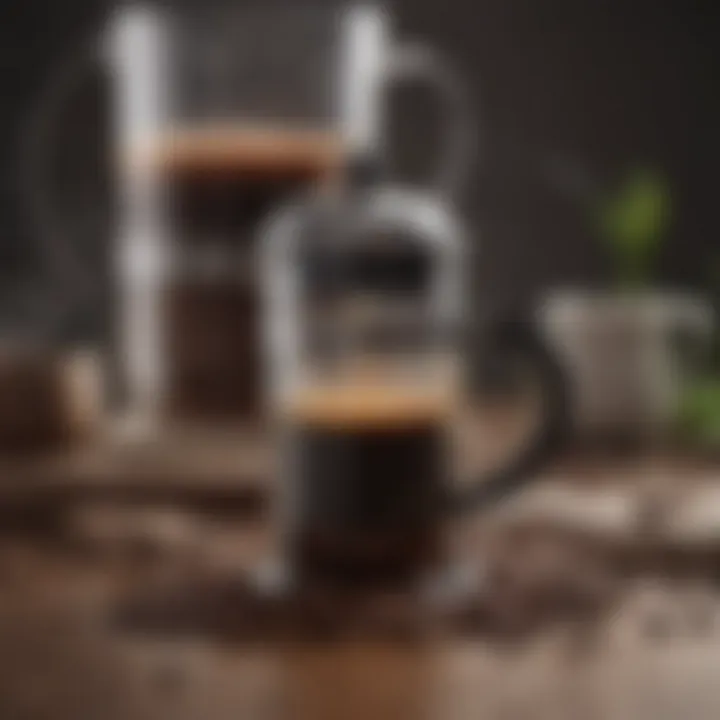
Intro
Brewing coffee using a French press is not merely a task; it's an experience that engages the senses. The aroma of freshly ground coffee mingling with hot water can transport anyone into a world of rich flavors. However, diving into the realm of the French press requires more than just an intuitive grasp of boiling some water and steeping coffee grounds. There’s a certain craft involved that, once mastered, allows one to create a cup that can rival that of any cafe.
In this guide, we will navigate through the fundamental components of French press brewing. We will cover everything from selecting the right coffee beans to the optimal movements for pressing the plunger. Additionally, common trappings and pitfalls that many beginners stumble into will be illuminated, ensuring you're not left out in the cold when it comes to making that perfect cup. Grasping these essentials not only enhances the brewing process but also sharpens your appreciation for the art of coffee.
Feature Spotlight
Quality Coffee Beans
A French press allows the full character of coffee beans to shine through. The key is selecting freshly roasted, high-quality beans. Look for brands that offer single-origin coffees, as these often exhibit unique taste profiles influenced by their geographic origins. Consider trying beans from regions like Ethiopia or Colombia, which typically add fruity and floral notes, respectively.
- Ethiopian Yirgacheffe: Known for its complex flavor with hints of jasmine and bergamot.
- Colombian Supremo: Offers a smooth body and flavors of caramel and nut.
Ideal Grind Size
Grind size is one of the deciding factors in achieving the right brew. For a French press, a coarse grind is preferred because it prevents clogging the mesh filter and allows for easier pressing. To help visualize this, consider the comparison:
- Coarse: resembles sea salt or peppercorns.
- Fine: similar to table salt.
Using the wrong grind can make or break your cup.
"The difference between a mediocre cup and an extraordinary one often lies in the grind size."
Water Temperature
Water temperature plays a crucial role, too. Ideally, the water should be around 200°F (93°C). Using water that's too hot can result in bitter flavors, while cooler water might not extract enough oils from the coffee grounds. Using a thermometer could be seen as overkill by some, but it can assure consistency.
Equipment Essentials
Utilizing the right tools can drastically improve your brewing process. Here’s a quick rundown of the necessary items:
- Quality French press (look for a model with a sturdy plunger and fine mesh).
- Coffee grinder (burr grinders are often recommended for uniform grind size).
- Kettle (preferably one that allows precise control over temperature).
- Scale (to measure your coffee and water accurately).
These tools promote consistency, ensuring you’re brewing at your best every time.
Common Mistakes to Avoid
Brewing with a French press can consume time and patience. Being aware of common mistakes can save headaches:
- Using stale coffee: Freshness is key to flavor.
- Too few grounds: Experiment with coffee-to-water ratios; a common starting point is 1:15.
- Uneven steeping: Stir the coffee after adding water to ensure even extraction.
Execution is essential; remembering these can grant you a smoother journey towards becoming a master brewer.
By focusing on these facets of the French press technique, one can gradually elevate their coffee endeavors into something remarkable. The joy of pressing the plunger, witnessing the brew transform into a fragrant concoction, and savoring that first sip is simply irreplaceable.
Understanding the French Press
When it comes to brewing coffee, there’s something quite special about the French press. The charm lies in its simplicity and how it engages the drinker in the process. Getting acquainted with the French press is not just about knowing how to operate it but also understanding its history, components, and the unique benefits it offers compared to other brewing methods.
Historical Background
The origin of the French press is a little murky, with multiple stories swirling around its inception. This device is believed to have roots that trace back to the early 19th century. While the Italians might lay claim to its invention, the French certainly popularized it. The result was a brewing device that combines elegance with function, transforming just boiling water and coffee into a rich, aromatic beverage.
Throughout the years, the design of the French press has evolved. The early versions employed metal screens and were made of ceramic or glass. Now, modern French presses often utilize borosilicate glass for resistance to thermal shock and stainless steel for increased durability. This evolution speaks to how the French press has adapted and remained a beloved brewing method, despite the rise of other technologies.
Components of the French Press
Understanding the parts of the French press is key to mastering its use. Each component plays a crucial role in the brewing process, ensuring that you get that perfect cup.
Carafe
The carafe is the heart of the French press. Made usually of glass or stainless steel, it is where the water meets the coffee. One important feature is its heat retention ability. A glass carafe, while visually appealing, can lose heat faster than a stainless steel option. Thus, while glass offers aesthetic appeal and visibility to monitor the brewing process, a stainless option ensures your coffee stays warm longer, which can be advantageous.
In addition, the size of the carafe matters. A larger carafe can brew multiple cups in one go, making it suitable for gatherings, while a smaller one might find its niche in the lives of solo drinkers. The versatility of the carafe makes it a great choice in the world of coffee brewing.
Plunger
The plunger, another vital component, has a simple yet effective mechanism. Its primary job is to separate the coffee grounds from the liquid after brewing. The key characteristic here is the mesh filter, which allows flavorful oils to pass through while keeping the grounds contained.
Choosing a French press with a durable plunger is essential, as this part undergoes daily usage. A well-built plunger can withstand the pressure needed to press down the coffee without any fuss. Thus, opting for such quality can enhance your overall brewing experience.
Filter Mesh
The filter mesh is what makes the French press unique compared to other brewing methods. Unlike paper filters that absorb the oils and fine particles, the metal mesh allows these essential flavors to seep into your cup. This results in a full-bodied coffee experience, with a richness that some claim can’t be obtained via drip methods.
However, it’s worth noting that using a mesh filter can sometimes lead to sediment in your coffee. This isn’t necessarily a dealbreaker, but it’s something to consider if you are particular about a smooth texture. Furthermore, mesh filters are often easier to clean than their paper counterparts, making the French press a more sustainable choice.
Why Choose a French Press?


There are several reasons to consider the French press as your go-to brewing method. First off, it provides unrivaled flavor due to the immersion process, which allows oils and micro-particles to elevate the taste profile of your coffee. Moreover, it’s relatively simple to use and requires minimal equipment. Plus, the aesthetic appeal of brewing your coffee in a French press can’t be ignored, making it a beautiful addition to any kitchen.
Essential Equipment
Understanding the essential equipment for French press brewing is paramount. It guides you in selecting the right tools, helping you to achieve that sought-after cup of coffee with perfect flavor and aroma. Investing in good equipment sets the stage for your coffee-making journey and ensures consistency with every brew.
Types of French Presses
Standard
The standard French press is the classic choice for many coffee aficionados. Its simplicity and ease of use contribute greatly to the enjoyment of brewing coffee. Made primarily of glass or stainless steel, it features a familiar plunger and filter mesh system.
The key characteristic of this type is its straightforward design, which makes it easy to see the coffee as it brews. This visual aspect allows the user to monitor the brewing process, which can be a valuable feature for mastering timing and extraction. A notable advantage is that standard presses are often more affordable and available in various sizes, accommodating different coffee needs, from a single cup to an entire pot.
However, one should be cautious as the glass can be fragile. Dropping it may shatter the carafe, which could lead to inconvenience.
Travel
Travel French presses are designed for those on the go. Compact and often insulated, they allow you to brew your coffee wherever you are. One major benefit is their portability—perfect for camping trips or business travels where you still want that home-brewed taste.
A standout feature is the thermal design in some models. This keeps your coffee hot for a longer period, ensuring you can savor the flavor over several hours. The downside, though, is they may not brew as much as standard options, which could be a limitation for frequent drinkers.
Electric
Electric French presses can elevate your brewing experience by taking the manual work out of the process. They usually include built-in heating elements, allowing for precise temperature control, which is vital for extracting the best flavors.
The convenience factor here is undeniably appealing—just press a button and let the machine do its magic. This means consistency every time, which is essential for those who value uniform flavor profiles. However, the trade-off is a larger upfront investment, and they often require more maintenance due to their electrical components.
Choice of Coffee Beans
Whole Beans vs. Ground
The choice between whole beans and pre-ground coffee sparks debate amongst enthusiasts. Whole beans are generally considered superior because they retain flavor and aroma until you're ready to brew. This freshness factor can significantly enhance the final cup of coffee.
When grinding at home, you control the grind size and timing, letting you tailor specifics to your taste preferences. Pre-ground coffee, on the other hand, offers convenience, particularly for the busy individual. It can be a quick solution but lacks that fresh kick. Thus, while ground coffee might save time, fresh grind from whole beans often delivers a more vibrant taste experience.
Grind Size Considerations
Grind size is another key factor in French press brewing. Using a coarse grind is ideal because it prevents over-extraction during the brewing process and promotes a smoother taste. Too fine a grind can lead to bitterness and a slurry-like mess that clogs the filter.
When considering grind size, think of it like cooking steak: A good cut deserves the right heat, and similarly, coffee beans need the correct grind to express their full potential. Sticking to coarse grinds helps maintain balance while ensuring flavors are evenly extracted during brewing.
Water Quality
Importance of Fresh Water
The significance of fresh water cannot be overstated when preparing coffee. Water's purity directly influences the flavor profile, making it an unsung hero of the brewing process. Using filtered water eliminates unwanted minerals or chemicals that may affect the coffee's taste.
Moreover, fresh water ensures that your coffee does not have any off-putting flavors, often attributed to stagnant water or contaminants. With good-quality water, your cup of coffee can reach its full potential.
Water Filtration Options
Exploring water filtration options opens up a path to enhance your brewing quality. There are several methods like using a faucet filter, pitcher filters, or even reverse osmosis systems. Each method has its own merits; for instance, a pitcher filter might be an economical choice if your tap water is subpar.
By opting for filtered water, you ensure that every sip maintains a clean and crisp taste. Avoiding the hint of chlorine or other additives results in a purer flavor. However, be aware that the initial costs can add up, especially with high-quality filtration systems.
Preparation Steps
The journey to crafting the perfect cup of coffee begins long before the first sip. In this section, we’ll explore Preparation Steps, a crucial phase in the French Press brewing process. Mastering these steps ensures that you’re set up for a successful brew, leading to a rich and flavorful experience rather than a bland disappointment.
Measuring Coffee and Water
Getting the quantities right with your coffee and water is pivotal. The general guideline is to use about 1 ounce of coffee per 15 ounces of water, but this ratio can vary based on personal preference.
Precision matters. Too much coffee can leave a bitter aftertaste, while too little results in a lackluster flavor. Using a kitchen scale can help, but if you prefer a more straightforward approach, measuring cup methods are just fine.
To make life easier, consider keeping a coffee diary. Note down your measurements and keep track of what worked for you. It’s like a blueprint for your ideal cup!
Heating the Water
Optimal Temperature Range
The optimal temperature range for brewing coffee in a French Press is between 195°F and 205°F. This range is just below boiling, which extracts flavors beautifully without burning the grounds. The importance lies in knowing that too hot can scorch the beans, muddying the delicate flavors, while too cool might not fully extract the desirable oils and essences.
- Key characteristic: It brings out the nuanced flavors of the coffee beans, ensuring a balanced cup.
- Unique feature: This range is considered a sweet spot for flavor extraction.
- Advantage: Gives coffee freedom to shine with rich flavors.
- Disadvantage: Maintaining this temperature can require a bit of attention, especially on a busy morning.
Methods for Heating
When it comes to methods for heating, the approach you choose can significantly affect consistency. Commonly, many opt for a kettle, whether electric or stovetop, to bring water to the ideal temperature. Which one you pick can boil down to personal preference and your morning routine.
- Electric Kettle:
- Stovetop Kettle:
- Benefit: Many feature temperature settings, allowing precise control.
- Drawback: They can be pricier than basic stovetop kettles.
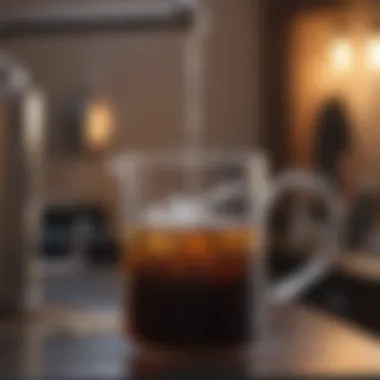
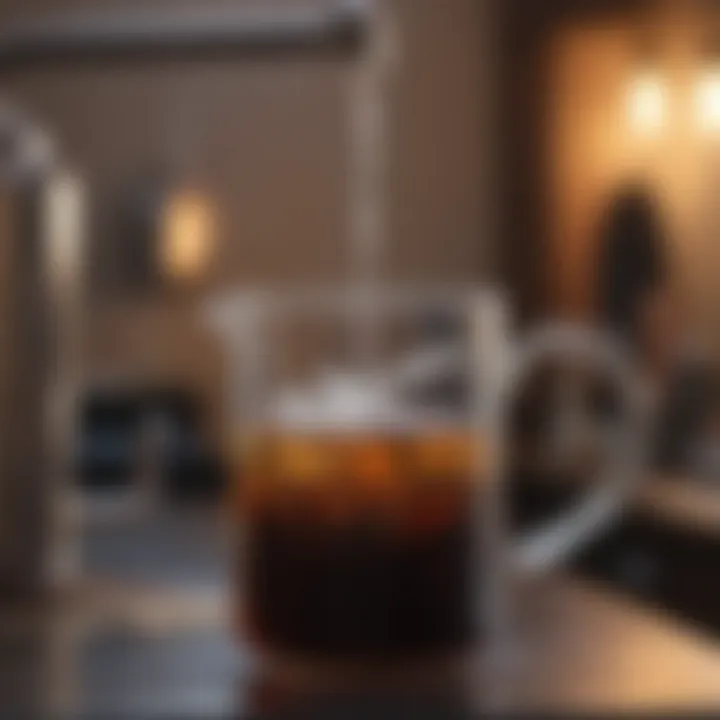
- Benefit: Often more cost-effective and easy to find.
- Drawback: Requires more monitoring to avoid overheating.
To ensure you're heating your water effectively, a simple thermometer can be a game changer. This small investment can help you reach that sweet temperature range consistently.
Grind Coffee to Perfection
The grind of the coffee matters more than many realize. For a French Press, you want a coarse grind, similar to sea salt. A finer grind may result in a gritty and bitter brew.
Here's the deal: a coarse grind will allow for proper extraction over a longer brewing period without over-extracting the flavors. If you're using whole beans, investing in a quality burr grinder will enable you to achieve this desired consistency.
In summary, the preparation steps form the backbone of a solid French Press coffee brewing process. By focusing on measuring your ingredients accurately, heating your water to the right temperature, and grinding your coffee correctly, you're already on your way to unlocking a café-quality experience right at home.
Brewing Process
The brewing process is the heartbeat of any coffee-making endeavor, particularly when it comes to using a French press. It is within this step that careful attention to detail can elevate your cup from good to downright unforgettable. Each moment in the brewing process holds significance; from adding coffee grounds to the pressing technique, every action contributes to the intricacies of flavor, aroma, and temperature stability. Mastering this process ensures your coffee is more than just a beverage; it becomes an experience, one reflective of the care and thought put into its preparation.
Adding Coffee Grounds
The first step in the brewing process involves adding coffee grounds, an essential act that lays the foundation for the flavor profile of your brew. The amount of coffee you decide to add can dramatically influence strength and character. Generally, a ratio of 1:15, coffee to water, is a good starting point. So, for every ounce of coffee, approximately 15 ounces of water is ideal.
Additionally, it’s worth noting that the grind size must be coarse. If it's too fine, it’ll slip through the filter mesh and lead to a sludgy coffee experience. Not quite the smooth operation most coffee enthusiasts hope for. The tactile satisfaction of pouring in the grounds must not be overlooked as it signals the beginning of a carefully constructed ritual.
Pouring Hot Water
Incorporating Coffee and Water
Incorporating water into the coffee grounds marks a transformative moment in the brewing process. This action is about more than just simply dousing the coffee; it's about creating a harmonious interplay between the two key components. As the hot water interacts with coffee, it extracts oils, flavors, and aromas, contributing to the resulting brew's complexity.
Key characteristic: The temperature of the water matters immensely here. Ideally, the water should be between 195°F to 205°F. Too hot? You'll scorch the coffee, leaving behind a bitterness that shoots straight to the back of your throat. Too cool? Your coffee will lack that rich flavor we all crave.
One unique feature here is the bloom that occurs right after you pour the water onto the coffee grounds. You'll notice bubbles forming, and the aromatic spectacle is your coffee releasing carbon dioxide. This, in itself, is a sign that you’re on the right path.
Stirring Techniques
Stirring might seem rudimentary, but it significantly affects how the flavors marry once the water is infused with the coffee grounds. When you give your brew a gentle stir right after adding water, you're ensuring that all the coffee grounds are drenched evenly. This helps in achieving a balanced extraction, resulting in a more harmonious flavor profile.
Key characteristic: A careful swirl, using either a wooden spoon or a paddle, can prevent clumps from forming. While metal utensils may scratch the glass carafe, wood is a safer choice.
One might think that stirring is optional, but consider it mandatory if you want to avoid uneven flavor, where some sips might be cold coffee flavored, and others might be richer.
Timing the Brew
Timing is critical in the brewing process. This is where patience really pays off—literally. A steeping time of around four minutes allows the water to fully extract the flavor from your coffee grounds.
Take a moment here; resist the urge to rush this crucial step. Oversteeping an already bloated brew can yield bitter elements while under-steeping can leave you wanting more. A timer can be your best friend, ensuring each cup meets your expectations.
Pressing Methodology
Plunger Technique
Using the plunger effectively is a pivotal part of the French press experience. When you're ready, grasp the handle firmly and press down evenly until the mesh filter separates the grounds from the brewed coffee. This is a tactile part of the process that many enjoy, as it feels like the culmination of your efforts.
Key characteristic: The pressure you exert can influence the final taste. An uneven or harsh plunge can lead to cloudiness and unwanted flavors being released. So take your time, remain steady, and aim for smoothness here.
Avoiding Over-Extraction
Lastly, calling attention to the importance of avoiding over-extraction is vital. If you leave the coffee grounds in contact with water for too long after plunging, you’ll likely end up tasting bitterness creeping in. The nuances you worked hard to highlight can diminish in seconds.
Key characteristic: Knowing when to stop is just as important as knowing when to push down. Monitor your brewing environment by observing time while also being aware of your palate. If coffee starts tasting too harsh and astringent, that’s your cue.
Making an art out of your brewing process with a French press isn’t just about going through the motions; it's about bringing mindfulness to each step to create a cup that reflects your efforts and yields satisfaction with every sip.
Post-Brewing Considerations
Understanding how to finish the brewing process is just as crucial as the brewing itself. Post-brewing considerations can make or break your French press experience. After all that effort and care put into creating that perfect cup, it's essential to know how to store and serve it properly. This section unpacks the vital aspects of pouring, serving, and storing coffee after brewing, ensuring that every sip is as delightful as the first.
Pouring and Serving
Pouring coffee from a French press is more than just a simple task; it's an art. When you pour, try to do so gently. This helps minimize the agitation of the grounds that may still be sitting at the bottom of the carafe. Pouring slowly is key, as it allows you to control the flow and avoid spilling. Take a moment to appreciate the rich aroma as it wafts towards you. When serving, consider using warmed mugs. Pre-warmed cups maintain the temperature of your beverage longer, enhancing the overall experience.
Another effective method to ensure that every cup served maintains its integrity is to use a carafe for sharing. Instead of pouring directly from the French press, transfer coffee into a heated carafe. This prevents the coffee from steeping longer, which can lead to bitterness. Plus, it creates an enticing presentation that can wow guests.
Storing Leftover Coffee
Sometimes, life happens and you might find yourself with leftover coffee. Rather than pouring it down the sink, understanding the storage methods that preserve its quality is essential.
Best Practices for Freshness
One of the best practices for maintaining freshness is to store leftover coffee in an airtight container if you intend to keep it for a while. This prevents oxygen from degrading the flavor. A common mistake is putting coffee in the refrigerator. While it seems logical, fluctuations in temperature can actually impact taste negatively. Instead, keeping it in a cool, dark place is more appropriate.
Store it for no more than a day to experience the best flavors. Many enthusiasts suggest using a thermal carafe as a great alternative; it keeps coffee hot without heating it over direct heat, protecting it from burning and subsequently altering its taste.

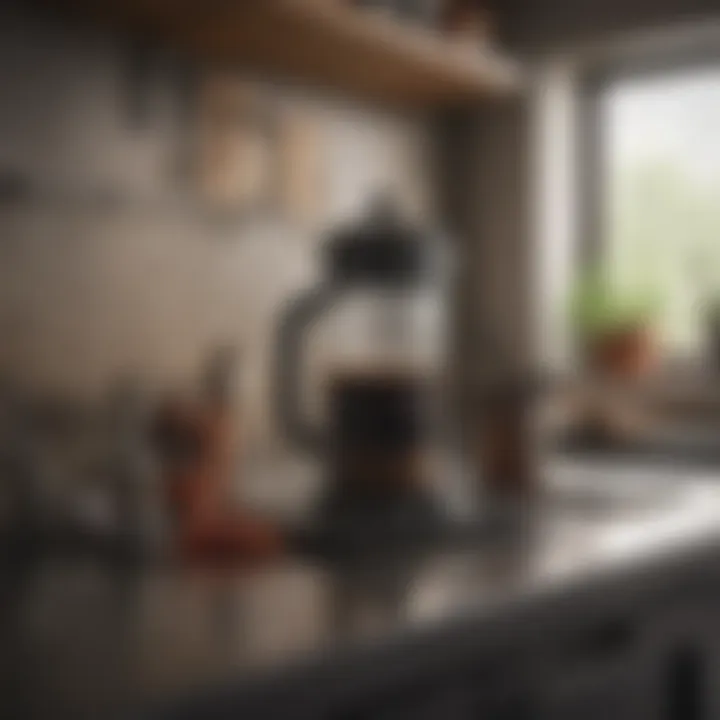
Avoiding Bitter Taste
An essential aspect of enjoying coffee is ensuring it doesn’t turn bitter. One way to avoid this unwanted flavor is to simply damage the integrity of the brew. Even after you have brewed it, if you leave your coffee in the French press, it continues to steep. This leads to over-extraction, which results in that dreaded bitter taste.
To combat this, make it a habit to enjoy or discard any leftover coffee within a few hours. Another technique is to add a drop of milk or a pinch of salt to mask any bitter tones, although it’s best to tackle the source of bitterness first. The idea is to give leftover coffee a second life, rather than it simply turning into a bitter affair.
"Fresh coffee is one thing, but stale coffee brings your experience down faster than a lead balloon. Know the right practices to keep your brew alive."
In essence, post-brewing considerations stretch beyond merely putting your feet up after brewing. It encompasses the entire lifecycle of your coffee, right up to how you choose to enjoy it. By keeping it fresh and avoiding bitterness, you contribute to an overall more rewarding coffee experience.
Maintenance and Care
Maintaining and caring for your French press is not just about keeping it shiny; it goes much deeper than that. It’s about preserving the quality of your brews and ensuring longevity for your equipment. When you take the time to care for your French press, you not only enhance the flavor of your coffee but also ensure a consistent brewing experience each time. Skimping on maintenance can lead to buildup of oils and residues that can affect taste and performance.
Cleaning the French Press
Daily Cleaning Routines
Daily cleaning routines are crucial to keep your French press functioning at its best. After every use, you should rinse the carafe and plunger under warm water. This practice helps in removing coffee grounds and preventing any leftover oils from solidifying, which could harm the flavor over time. The key characteristic of daily cleaning routines is simplicity — you don’t need to invest a ton of time or elaborate methods for this step.
One of the most beneficial aspects of a daily cleaning routine is that it maintains the quality of your coffee. If you neglect this process, remnants from previous brews can mix with your fresh coffee, leading to less-than-ideal flavors. While it might seem like a small detail, it significantly affects the overall enjoyment of your brew.
Unique features of daily cleaning routines include using warm, soapy water to clean the filter and carafe. Although this might seem straightforward, having such a routine creates a habit that not only keeps your French press clean but also serves as a daily reminder of the coffee ritual itself.
Deep Cleaning Instructions
Deep cleaning instructions come into play when you want to ensure that your French press is spotless and free from any stubborn stains or built-up oil. This process typically involves a thorough scrub and can be done once every few weeks. Deep cleaning is beneficial for truly retaining the quality of your coffee and averting any unwanted flavors.
A unique aspect of deep cleaning is the use of cleaning solutions or vinegar to break down tougher stains. When added to warm water, these natural substances can work wonders. The primary advantage here is ensuring that the inside of your French press is as good as new, making sure previous flavors do not linger. However, overuse of certain cleaners can sometimes lead to wear and tear. Thus, care should be taken in what products you choose to use.
Avoiding Common Pitfalls
Clogged Filters
Clogged filters are a common headache for many French press owners. Over time, fine coffee grounds and oils accumulate, hindering the ability of the filter to separate the brew from the grounds efficiently. This can lead to a sludgy experience in your cup and can spoil the enjoyment of your coffee.
The key attribute of addressing clogged filters is timeliness. If you find your French press isn’t filtering as well as it used to, taking swift action can mitigate further problems. Regularly rinsing the filter and ensuring it’s clear of blockages after every use can save a lot of trouble later. Incorporating dedicated maintenance can help you avoid this issue more often than not.
While the prospect of a clogged filter seems minor, its impact on the overall brewing experience is significant. You might find yourself battling more flavors than you bargained for if you ignore this aspect.
Scratched Carafes
Scratched carafes might sound trivial, but they pose a surprisingly significant issue for French press lovers. Over time, as you use your press, scratches can form on the glass or stainless steel, leading not just to aesthetic concerns but also affecting the flavor of your coffee. Scratches can harbor coffee oils and residues that compromise the taste.
The worrisome characteristic of scratched carafes is that they can usher in unwanted tastes from previous potions. For instance, even a slight scratch can become a home for residual flavors, which manifests in the next brew. Hence, it is wise to handle your press with care, avoiding abrasive cleaning materials that can magnify this problem.
One of the unique features of focusing on preventing scratches is understanding the materials you are using. Investing in quality products helps ensure that your French press stands the test of time and protects itself from daily wear and tear. Keeping this in mind, you might find yourself not just caring for your press but also enjoying a more refined brewing experience overall.
Exploring Variations
Exploring the variations in French press brewing is a key component that can lead to unique experiences and flavors. Each variation adds a layer of complexity and personal touch to the coffee-making ritual. This section investigates different infusion methods and alternative brewing techniques, emphasizing the creative potential within the boundaries of a French press. By understanding these variations, readers can enhance their brewing expertise, ensuring that each cup brewed can be tailor-made to their individual palate.
Infused Coffee Variants
Infused coffee variants stand out as an exciting way to experiment with flavors and aromas. Traditional French press coffee generally allows the natural flavors of the coffee beans to shine, but adding ingredients like spices, herbs, or even citrus zest can take the experience to a whole new level.
- Spices: Think cinnamon, cardamom, or nutmeg. Just a pinch can add warmth and depth, changing your daily cup into a delightful aromatic experience.
- Herbs: Fresh mint or basil might sound unusual, but they can uplift the brew, creating refreshing accents.
- Citrus Zest: Adding pieces of lemon or orange peel during brewing can make for a bright and energizing cup.
Alternative Brewing Methods
Pour-Over
Pour-over is an alternative brewing style that emphasizes control and precision. This method involves a manual pour of hot water over coffee grounds in a filter, which allows the coffee to bloom and extract flavors gradually. Its distinctiveness lies in the fact that the brewer can adjust the pouring rate, angle, and timing—variables that drastically influence the taste.
Many choose pour-over for its clarity and brightness, traits not found in every coffee-making method. The streamlined process, often involving a conical dripper like the Hario V60, allows for a more controlled extraction, which can be very satisfying for coffee enthusiasts. However, it might be seen as more time-consuming compared to the French press, especially in a fast-paced environment. Ultimately, the pour-over method shines in bringing out the nuanced profiles of specialty coffee that might go unnoticed in other brewing systems.
Aeropress
Aeropress represents another flexible alternative to the French press that is revered by many for its ability to brew a rich, smooth coffee. This device combines immersion and pressure, using a piston to push hot water through coffee grounds.
Its charm lies in its portability and easy cleanup, making it a favored choice for travelers and minimalists. Another highlight is the versatility it offers—brewers can experiment with steeping times and grind sizes to achieve varied results. However, while it artfully crafts coffee, the Aeropress's output does lack the same body and oils that a French press showcases, which means it might not satisfy those who fancy the fuller, thicker mouthfeel of a traditional French press brew.
"Brewing is an art that thrives on creativity, and exploring variations is where true mastery lies."
Finale
One of the most crucial elements discussed is the attention to detail in both preparation and process. From selecting high-quality beans to carefully monitoring grind size and water temperature, each step can either enhance or mellow the final flavor. Many tend to overlook how important even the simplest choice can be; after all, your coffee is only as good as its components.
The benefits of exploring various brewing methods, as noted, allow for individual preferences to shine. Whether one prefers a bold infusion or a lighter brew, understanding the French press opens a gateway to a plethora of flavors waiting to be discovered. Variations, like infused coffee, not only showcase creativity but highlight an engaging journey for the taste buds.
Moreover, proper maintenance and care of the French press ensure that it remains an integral tool in your coffee-making repertoire. Regular cleaning and addressing common pitfalls fortify the longevity of the device, allowing countless cups of coffee to be brewed without losing quality.
In summary, the journey of mastering the French press showcases the beauty of a simple yet complex brewing method. It encourages exploration and experimentation, providing a rich tapestry of experiences that resonates with both novice brewers and seasoned aficionados. By investing time and care into this process, coffee lovers can unlock their true potential and bring joy into each sip they take.
"Great coffee is the sum of many small decisions, each one a step towards a delightful experience."
In closing, approaching coffee with curiosity and dedication can lead to discover new depths of flavor, inviting a delightful conversation with every brew.







